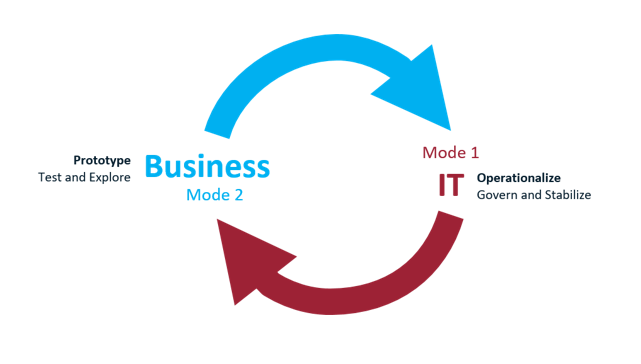Building a Bridge Between Business and IT
You walk down the long hall, and tentatively knock on the side of a cubicle, just loud enough to be heard over the din of keyboard clicking. The occupant of the chair slowly spins around. “Yes?”
“So, um, I was wondering about that report I requested…”
“Yes I remember” comes a flat reply. “We’re still looking into it, I’ll let you know in a week, OK?”
The chair spins back around, keyboard sounds resume.
“Well actually…” you start to protest, but think better of it. “OK, I guess.”
At one point in time, this was how the Business world functioned. The IT department was the single source for tools, data and infrastructure. Every request, every ticket, went through their rigorous processes. Sometimes you got what you needed in time, but other times, going through IT was infuriatingly slow.
At some point in the recent past, a tide came in that changed the landscape. We entered the era of big data, and companies found that they had a major advantage through data analysis. The demand for more data and better insights became insatiable. Today, companies need these capabilities just to keep up with everyone else. The net effect is that IT became too large of a bottleneck. There’s just too much new data pouring in from different sources for IT to handle in a reasonable time frame. The Business can’t afford to wait for IT, it needs answers now. Something had to change.
And change it did. Self-service analysis tools and cloud software have filled this gap, which enable Business people to go around IT. If you’re working outside the wall, it doesn’t matter if IT is the gatekeeper. Business people purchase their own user-friendly tools, hire Data Scientists, and then venture out on their own, diving into the deep world of raw data, hunting for game-changing insights. We live in a decidedly “Mode 2” world today – a world where our style of work is focused on being exploratory and experimenting to solve new problems1. In today’s world, the business moves as fast as it wants, and IT clings for dear life.
Beneath the Clouds
As businesses are starting to see now, this new world is not exactly a utopia. Beneath the clouds there have been some real, ground-level pains. Semi-technical people now have to deal with questions like, “how do I get this data from here to there?” and “how exactly do we mashup all these files?”
 Business people are not waiting for IT anymore, but now they are scratching their heads with configurations, and burdened with the time-consuming manual effort involved in moving data around. These new, informal processes often have major inefficiencies, depending on both tool capabilities and comfort levels. You’ll see people do things in strange ways, such as downloading data from an Analytics tool, importing the data into Excel to combine it, then pulling it back into the Analytics tool again.
Business people are not waiting for IT anymore, but now they are scratching their heads with configurations, and burdened with the time-consuming manual effort involved in moving data around. These new, informal processes often have major inefficiencies, depending on both tool capabilities and comfort levels. You’ll see people do things in strange ways, such as downloading data from an Analytics tool, importing the data into Excel to combine it, then pulling it back into the Analytics tool again.
More importantly, this story isn’t just playing out in one or two renegade Business Units, it’s happening everywhere. When every department goes their own way, chaos ensues. There’s a very real cost to buying multiple tools that do the same thing. Then there’s the unquantifiable cost of losing the full picture. It becomes even more difficult to make sense of the company’s data when it’s trapped in silos and scattered across 50 different tools.
At some point, you are going to want to integrate a lot of this data. How do we know if the data is good? How do we know that everyone is making the right assumptions in their data, or even defining things the same way? If you want your data to really be useful, you have to be able to trust it. But in Mode 2 analytics, data quality and governance tends to get ignored. It’s possible to get away with it in the beginning, but it catches up with you as you try to scale and integrate with larger systems. Integration, governance, traceability—these are exactly the topics where IT excels. So it’s not really surprising to see Business come back to IT for help, after they’ve made a mess of things. You can imagine IT’s reaction when someone says, “hey, we’ve got our data in these various tools, and we want it to work together, and we need it to be fast.” IT sees how much work it’s going to be, work that could have been avoided if people thought ahead and worked together from the start. Conversations like these often end up at an impasse.
Finding a Way Forward
At Ironside, we’ve seen this story play out in countless ways. Untangling this mess is difficult, but perhaps the hardest part is simply getting IT and Business on the same page. To find a path that really works, you’ll need both parties on board, and get them to understand that they can—and should—partner in alignment with organizational strategy and goals. It’s necessary to move the conversation beyond Mode 1 versus Mode 2, to Mode 1 and Mode 2; the Bimodal delivery model.
This is as much a story about IT “learning how to surf”, as it is about Business rediscovering an old ally who can help navigate the waters.
In the Bimodal model, you’ll draw on the strength of what each side does best. Analysts, Data Scientists and subject-matter experts on the Business side use Mode 2 tools to explore new data, and answer the question: what data is useful and valuable? From there, Business and IT work together to define, master, and refine the data, at which point IT builds out a robust, traceable, scalable, secure and repeatable solution. While Mode 2 work may be exploratory and unplanned, it doesn’t have to be a surprise. When Business and IT work together, exploratory activity becomes part of a larger process instead of a disruption. A shared set of goals and a new perspective on roles can energize both IT and Business, and create a positive feedback loop that make the whole greater than the sum of the parts.

Bridging this gap takes time, and it starts with forming a shared understanding of reality; what is really happening in the business, and why. Working together, IT and Business begin with research, to capture the organization’s key use cases.
A good place to start is with interviewing a representative sample of your stakeholders and users. Your goal here is to uncover a true and detailed picture of how the work gets done today, and why it gets done this way. Think of your role in this phase as an investigative reporter; you go where the action is, observing what goes on, and collect people’s stories. What you’ll find will surprise you – reality is always different from what you assume. The stories and scenarios you encounter will help you pinpoint exactly what’s working and what’s not, and will help you develop an actionable Data & Analytics Roadmap.
Business and IT are natural allies, and often, the missing ingredient of collaboration is a shared vision. By coming together to understand the full picture and establish a Roadmap, both parties can see how they contribute to each other’s success, and can put an end to chaos and communication breakdown.
References
1 “What is Bimodal IT? See Gartner’s IT Glossary For The Answer.” Gartner IT Glossary, 21 Feb. 2017, www.gartner.com/it-glossary/bimodal/.
About Ironside
Ironside was founded in 1999 as an enterprise data and analytics solution provider and system integrator. Our clients hire us to acquire, enrich and measure their data so they can make smarter, better decisions about their business. No matter your industry or specific business challenges, Ironside has the experience, perspective and agility to help transform your analytic environment.






